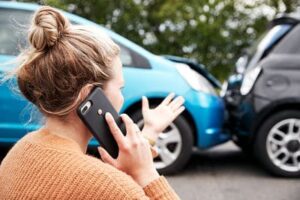 Imagine you’ve just been in an auto accident, which is one of the most traumatic events you can experience in everyday life. You’re in shock, you’re confused, and to make matters worse, you’re injured. Fortunately, you have the presence of mind to exchange insurance information with the driver who hit you. You do the right thing and alert your insurance company so that you can begin the process of getting the medical care you need to recover from your injuries.
Imagine you’ve just been in an auto accident, which is one of the most traumatic events you can experience in everyday life. You’re in shock, you’re confused, and to make matters worse, you’re injured. Fortunately, you have the presence of mind to exchange insurance information with the driver who hit you. You do the right thing and alert your insurance company so that you can begin the process of getting the medical care you need to recover from your injuries.
A short time passes, however, and when your insurance company contacts you, you hear one of these two seemingly worst-case scenarios:
- There is no insurance available for the vehicle that struck you; or
- There is insurance for the vehicle that struck you, but the cost of your injuries far exceeds the maximum amount that the insurance policy will pay out.
You panic. What do you do? Is there any way to make yourself financially whole again?
Actually, there may be hope, in the form of Uninsured/Underinsured Motorist (UM/UIM) Coverage.
Auto Insurance in Illinois: Some Basics
Illinois law requires vehicle owners to carry policies with two types of auto insurance:
- Liability/Body – This type of insurance is designed to cover the medical or other costs for the bodily injuries or deaths that result from a collision caused by the policyholder’s negligence.
- Property – This portion of an auto insurance policy covers damages to the property of others during a collision, including damages to the vehicle itself, personal items inside the vehicle, pets, and other private items, such as mailboxes, fences, homes, and yards.
The minimum requirements for each type of insurance in the state of Illinois are:
- $25,000.00 for the injury and death of an individual per incident;
- $50,000.00 for the injuries and deaths of all parties per incident; and
- $20,000.00 for property damage per incident.
Illinois penalizes drivers for not having at least state minimum coverage, or for having no coverage at all. Driving without any insurance or without state minimum insurance can result in fines or even suspension of a driver’s license.
Policies may exceed the state minimum requirements in Illinois, but the insurance company issuing the policy for the at-fault party has no obligation to pay more than the maximum amount mandated in that policy. Therefore, if the at-fault vehicle has a policy with limits of 25/50/20, the most the insurance company will pay out for a given incident is:
- $25,000.00 for a single injured or deceased individual;
- $50,000.00 for all injured or deceased parties;
- $20,000.00 for all of the property damaged.
(For the purposes of this article, we will focus our attention solely on the liability/body insurance earmarked to cover expenses in the case of personal injury and/or death, though the following scenarios could potentially apply to property damage.)
While these dollar amounts are not exactly small, you could probably imagine expenses that exceed the policy limits in the case of injuries sustained in a serious collision. For example, say you are injured by another vehicle’s negligence, and your own medical bills, lost wages, and other related expenses are far greater than the $25,000.00 covered by the vehicle’s state minimum policy. What do you do then?
Before we examine the role of UM/UIM Coverage, let’s first take a look at two other forms of financial compensation potentially available for bodily injury and/or death resulting from the at-fault vehicle’s negligence.
Umbrella Policy
The owner of the at-fault vehicle may have an umbrella policy. An umbrella policy offers additional liability insurance coverage above the limits of someone’s auto, home, or boat insurance policies. Umbrella policies are designed to kick in when the limits on these other liability policies have been exhausted.
For example, if the owner of the vehicle that injured you has a policy with 25/50 liability/body coverage, but also has an umbrella policy with limits in excess of his or her auto insurance policy, you could potentially tap into that umbrella policy IF you have already exhausted the $25,000.00 individual limits available in the auto insurance policy.
Driver’s Insurance Policy
Maybe the driver who struck you was not the owner of the vehicle, but merely somebody who was borrowing this vehicle with the owner’s permission.
In that case, once the owner’s total insurance coverage for that vehicle is exhausted, you could potentially pursue a claim against the driver’s own auto insurance policy, IF the driver has such a policy, and IF the driver’s policy limits are greater than the limits on the owner’s total insurance coverage.
But if the driver does not have his or her own policy, or if the driver’s policy does not have policy limits greater than those of the owner’s total insurance coverage, then there may be no additional means to obtain financial compensation from the at-fault vehicle.
However, there may still be a way to be compensated for your injuries from the insurance policy for the vehicle in which you were traveling, whether it was your own vehicle or if you were only a passenger, by using the vehicle’s Uninsured/Underinsured Motorist (UM/UIM) Coverage.
Uninsured Motorist Coverage
Uninsured Motorist (UM) Coverage is essentially what it sounds like: It offers coverage for injury expenses incurred when the at-fault vehicle and/or driver has no insurance coverage. As with liability coverage, the amount available for potential recovery is capped by the maximum limits of the insurance policy. Therefore, if the vehicle has 25/50 uninsured policy limits, the most that injured parties driving or riding in that vehicle could recover from that policy is $25,000.00 for an individual and $50,000.00 total per incident.
Underinsured Motorist Coverage
Underinsured Motorist (UIM) Coverage is designed to provide additional financial compensation once the insurance for the at-fault vehicle has been maxed out, provided that the UIM coverage has policy limits exceeding those of the at-fault vehicle’s insurance coverage. If it does not, there is no means of recovery from the UIM policy.
For example, say the at-fault vehicle has insurance coverage with 25/50 policy limits, and you, an injured party, have already recovered the full $25,000.00 available from that policy. The costs for your medical treatment far exceed $25,000.00, so you file a claim against the UIM policy of the vehicle in which you were traveling.
If the vehicle has, say, 50/100 UIM policy limits, the maximum available for you to recover for your injuries would be an additional $25,000.00 because you have already recovered $25,000.00 from the other vehicle’s liability policy. ($50,000.00 UIM max – $25,000.00 liability max = $25,000.00 remaining UIM coverage.)
If, however, the vehicle in which you were traveling also has 25/50 UIM policy limits, there would be no additional funds to recover from the UIM policy because the $25,000.00 individual liability coverage has already been exhausted. ($25,000.00 UIM max – $25,000.00 liability max = $0.00 remaining UIM coverage.)
UM/UIM Coverage and Pedestrians
But what if you weren’t driving or riding in a motor vehicle at the time of the collision? What if you were a pedestrian who was struck by an uninsured/underinsured motor vehicle? Can you still seek UM/UIM compensation? The short answer? Maybe!
If you own a vehicle that has UM/UIM coverage, you will likely be able to tap into that coverage if you are injured by an uninsured/underinsured vehicle, even if you were not in your vehicle at the time of the collision.
If you don’t own a vehicle with a UM/UIM coverage, you may still be able to seek compensation if you are injured by an uninsured/underinsured vehicle, provided that you reside with a relative who has an auto insurance policy with UM/UIM coverage.
In both scenarios, restrictions in the individual UM/UIM policies may apply, so it is important to examine the contractual language closely and to seek out all possible avenues of recovery.
Chicago Car Accident Lawyers
Though far from exhaustive, we hope that you found this short introduction to UM/UIM Coverage informative. Each auto accident is different, so it is impossible to cover every potential scenario in a brief article, but you can see how complicated overlapping layers of insurance coverage can be. Moreover, you may also see how important it is to identify all of the avenues of recovery available to you in order to maximize your financial compensation when you are injured in an auto accident through no fault of your own.
For this reason, many auto accident victims find that they may benefit from the guidance of an experienced and knowledgeable attorney, like the Chicago car accident lawyers at GWC Injury Lawyers, Illinois’ largest Personal Injury and Workers Compensation law firm.
If you have been wrongfully injured, in an auto accident or in some other way, please contact GWC today to schedule a free consultation with one of our attorneys. Call our office at (312) 464-1234 or click here to chat with one of our representatives.
<< BACK TO BLOG POSTS